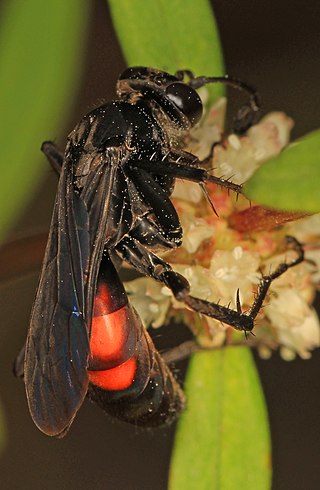
The black-and-white-casqued hornbill also known as the grey-cheeked hornbill, is a large black and white hornbill. It has an oversized blackish bill with a large casque on top. The female is slightly smaller than the male and has a significantly smaller casque. It is a monogamous species, and pairs nest in suitable tree cavities. The female usually lays up to two eggs. The diet consists mainly of figs, fruits, insects and small animals found in the trees.

Anoplius is a genus of spider wasps in the family Pompilidae, called the blue-black spider wasps. It is one of two genera within the tribe Anopliini of subfamily Pompilinae.
Cimmerites is a genus of beetles in the family Carabidae, containing the following species:

Anoplius viaticus, commonly known as the black-banded spider wasp, is a species of spider wasp. These wasps are known as spider wasps because the females capture spiders to provide their offspring with food. The paralysed spider is cached in a burrow, the wasp lays an egg on it, and when this hatches, the developing wasp larva consumes the spider. This species is found in sandy heathland across most of Europe.
Anoplius infuscatus is a species of spider wasp found mainly in Eurasia.

Anoplius americanus is a species of blue-black spider wasp which is widely distributed in the New World.
Anoplius virginiensis is a species of spider wasp in the family Pompilidae.
Anoplius illinoensis is a species of spider wasp in the family Pompilidae.
Eugonus is a genus of fungus weevils in the beetle family Anthribidae. There are about 18 described species in Eugonus.
Anoplius cleora is a species of spider wasp in the family Pompilidae.

Anoplius apiculatus is a species of spider wasp in the family Pompilidae.

Anoplius aethiops is a species of spider wasp in the family Pompilidae. It primarily lives in overgrown fields with fine-grained soil. It provisions its young with paralyzed Lycosidae spiders, especially those of the genus Hogna.

Anoplius atrox is a species of spider wasp in the family Pompilidae.
Anoplius carolinus is a species of spider wasp in the family Pompilidae.
Eulechriops is a genus of true weevils in the beetle family Curculionidae. There are more than 80 described species in Eulechriops. The genus name is masculine, contrary to some sources, following ICZN Article 30.1.4.3: "A compound genus-group name ending in -ops is to be treated as masculine, regardless of its derivation or of its treatment by its author."

Anoplius semirufus is a species of spider wasp in the family Pompilidae.
Anoplius ithaca is a species of spider wasp in the family Pompilidae.

Omus californicus, the California night-stalking tiger beetle, is a species of tiger beetle in the family Cicindelidae. It is found in North America.

Orestes subcylindricus is a species of stick insects native to Vietnam.

Ceropales bipunctata, the Two-Speckled Cuckoo Spider Wasp, is a species of diurnal, kleptoparasitic spider wasp in the family Pompilidae. It is an obligate kleptoparasite, meaning that it must rely on the captured provisions of other spider wasps and cannot capture its own. It is found on the Atlantic Coast of North America, north to New Brunswick, Canada. It feeds on nectar primarily from goldenrods, and also other common nectaring plants. It is known to lay an egg on the prey of other pompilids, including the two species Anoplius cleora and Anoplius aethiops. Eggs are laid in the book lung of the spider. These wasps also sometimes lay an egg on prey from spider-hunting wasps in the family Sphecidae.











